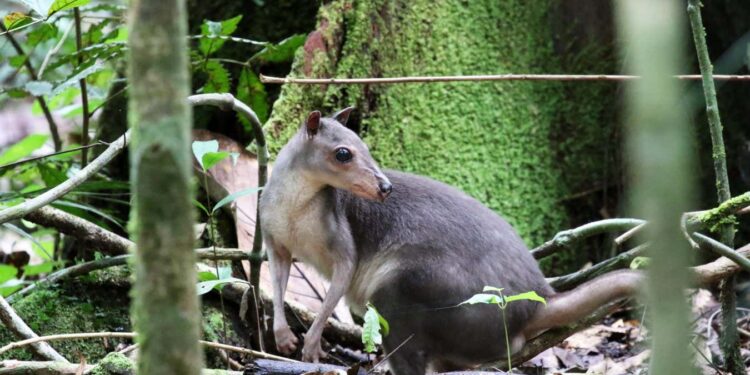
Brown forest wallabies spread to several islands thousands of years ago
Mehd Halaouate, Birdingindonesia.com
As early as 12,800 years ago, people captured wild wallabies and transported them in canoes to islands dozens or even hundreds of kilometres away.
Native to Sahul – the prehistoric landmass that later split into Australia and New Guinea – the marsupials probably accompanied human explorers and traders to islands across South-East Asia as sources of food, decorative pelts and eventually bone tools. The imported animals established colonies and thrived there for thousands of years, in one of the world’s oldest known cases of animal translocation, says Dylan Gaffney at the University of Oxford.
“This builds into a global picture where these early people were moving, managing and rearing animals in much more complicated and purposeful ways than we thought – possibly in some ways that early agriculturalists would have,” he says. “They weren’t just surviving in these tropical island environments; they were actively shaping them.”
Scientific work on species translocations has typically focused on European explorers – like their introduction of invasive rabbits into Australia in the 18th and 19th centuries, or the reintroduction of horses to the Americas in the late 1400s and early 1500s.
But in the 1990s, researchers found bones of two kinds of marsupials – the cuscus (Phalanger orientalis breviceps or Phalanger breviceps) and the bandicoot (Echymipera kalubu) – on islands east of New Guinea, and brown forest wallabies (Dorcopsis muelleri) on islands as far west as Halmahera, about 350 kilometres away from the ancient coastline of Sahul.
Based on the age of nearby charcoal and the depth of the remains, those teams estimated that the wallabies arrived about 8000 years ago, and the other animals between 13,000 and 24,000 years ago.
How those animals got to the islands – whether by human transport or on their own – has not been established. To find out, Gaffney and his colleagues investigated a new archaeological site in the Raja Ampat Islands in Indonesia, which lay a few kilometers offshore from northwest Sahul when sea levels were low thousands of years ago.
There, skeletons with ages thousands of years apart suggest that colonies of brown forest wallabies lived and reproduced on the islands for generations before vanishing about 4000 years ago, for reasons yet unclear.
Radiocarbon dating in an inland cave showed people were butchering and cooking wallabies as early as 13,000 years ago – 5000 years earlier than on islands further west – and were still doing so around 4400 years ago.
The team also found several bone tools – probably used for hunting and textile work – dating to at least 8500 years ago, including one confirmed by molecular analysis to have been made from a bone of the wallaby family about 4300 years ago.
To address the question of how the animals got there – and to islands farther away – the team used computer modelling, accounting for sea levels and environmental conditions at the time.
The modelling supports the idea that humans transported the animals by canoe, Gaffney says. Without human help, the wallabies would have had to swim across the open ocean for more than 24 hours in powerful currents or cling to vegetation rafts for up to 10 days to reach some of the islands, making their survival highly unlikely. And while it is feasible that the animals could have reached nearby islands by swimming, no one knows whether forest wallabies – modern or ancient – could swim at all.
Canoe trips, by contrast, would have lasted just a few hours to two days depending on the route – probably short enough for captive animals to survive the trip, he says.
The findings highlight just how far back human-driven species movements go – well before European colonial expansion, says Tom Matthews at the University of Birmingham, UK, who wasn’t involved in the study. “We often assume introductions only started in the last 500 years, but this shows humans were reshaping ecosystems thousands of years ago.”
Topics:
Source link : https://www.newscientist.com/article/2485490-ancient-people-took-wallabies-to-indonesian-islands-in-canoes/?utm_campaign=RSS%7CNSNS&utm_source=NSNS&utm_medium=RSS&utm_content=home
Author :
Publish date : 2025-06-24 10:00:00
Copyright for syndicated content belongs to the linked Source.




